#or a counteroffensive along a different axis
Explore tagged Tumblr posts
Text
One question I had, just sort of an idle curiosity thing, was after the Russian forces withdrew from Ukraine in the northeast, what kept the fighting isolated mostly to the southeast, and what did the rest of the border look like between these two countries that were at war? Just guys with guns staring tensely at each other over the border fence?
Well, it turns out the answer to the first part of that question was “not a lot”!
#very crazy stuff#but if your option is throwing people into an endless meat grinder#or a counteroffensive along a different axis#I see why you would prefer option 2#seems like the objective here is to fuck up russian logistics#which might work#esp if trade sanctions are making it hard to keep the railroads running as is
23 notes
·
View notes
Text
The 10 Decisive Battles of World War II
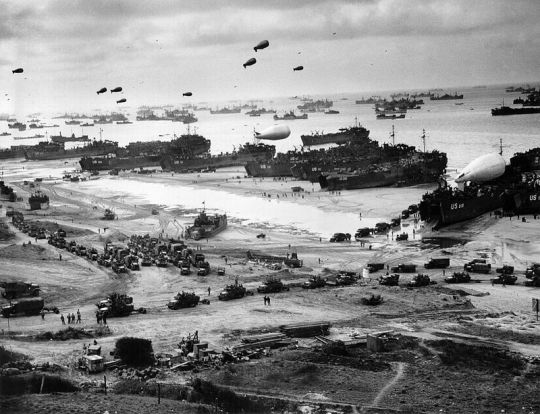
U.S. Landing Ships delivering vehicles and supplies to American troops on Omaha Beach during the Allied invasion of Normandy. Many regard this as the decisive battle in the European Theater of World War II.
In the seventy years since the end of World War II, the legacy of the largest and deadliest conflict in human history remains prevalent to this very day. It was a global conflict fought with incredible ferocity, leaving entire nations devastated, millions dead, and many more wounded. To forget the lessons of this great and terrible war would be a disservice to the sacrifices made by so many. At least 50 million people died in World War II, but others suggest that the total number is higher than 80 million, including war-related factors such as disease and famine. The conflict pitted the Axis Powers, a fascist military alliance made up of Nazi Germany, Italy, the Empire of Japan, and several other nations, against the Allied Powers, an international coalition led by the United States of America, Great Britain, France, the Soviet Union, and China.
The war began on September 1, 1939, after Nazi Germany invaded Poland, compelling Great Britain and France to declare war against Germany. The conflict expanded into the Pacific on December 7, 1941, after the Empire of Japan launched a pre-emptive strike against the U.S. Pacific Fleet based at Pearl Harbor, Hawaii. This list covers a series of battles fought during the war which held the greatest strategic implications, where the difference between victory and defeat could have changed the course of history. These are the ten decisive battles that ultimately decided the outcome of World War II.
10) The First and Second Battle of El Alamein
Date: July 1- November 11, 1942
Location: El Alamein, Egypt

July 17, 1942: British troops man defensive positions just outside El Alamein, Egypt.
For two years, the North African Campaign had been a series of seesaw battles fought back and forth across the Libyan Desert between the Axis Powers of Nazi Germany and Italy, and Allied forces primarily from British Commonwealth nations. In June 1942, German and Italian troops of Panzer Army Africa were pushing deep into Egyptian territory. Led by the legendary German Field Marshal, Erwin Rommel, Axis forces were threatening to advance on Alexandria, Cairo, and the Suez Canal. With the fate of North Africa and the Middle East in the balance, the British Eighth Army made a stand at the coastal town of El Alamein. Confined along a narrow front between the Mediterranean Sea to the north and the impassable Qattara Depression to the south, Panzer Army Africa was unable to outflank the British defense line. The First Battle of El Alamein (July 1- 27) ended in a bloody stalemate with heavy losses on both sides, but the Allies had finally managed to stop the Axis advance.
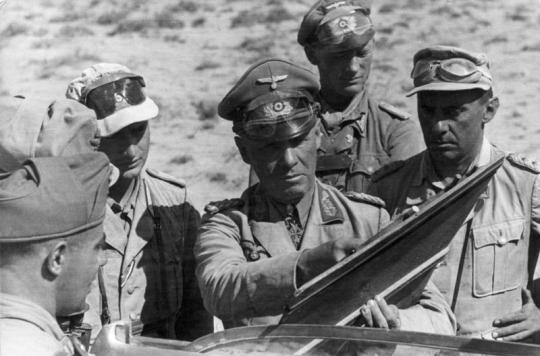
June 21, 1942: The commander of Panzer Army Africa, Field Marshall Erwin Rommel, speaks with German and Italian officers during the Western Desert Campaign.
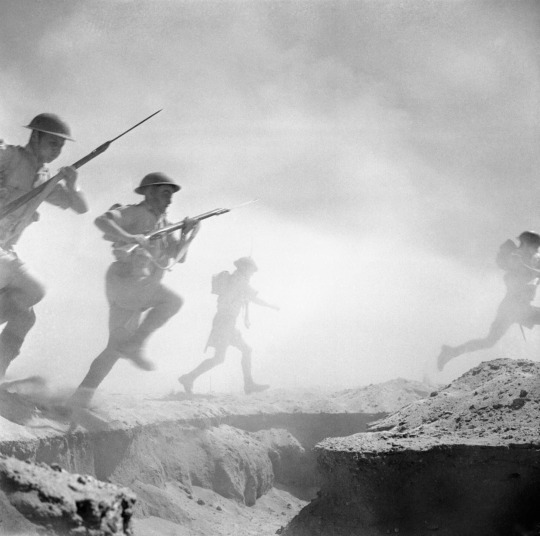
October 24, 1942: Australian troops of the 9th Infantry Division charge into combat during the Second Battle of El Alamein.
Rommel desperately needed reinforcements and supplies, but Germany and Italy had committed their efforts to defeating the Soviet Union on the Eastern Front, while the Allies poured troops and resources into Egypt for a major counter-offensive. In the Second Battle of El Alamein (October 23- November 11), the British Eighth Army, now led by the audacious General Bernard Montgomery, launched an all-out attack that finally broke through the Axis defense line after bitter fighting and heavy losses on both sides. Losing almost one third of their strength, Panzer Army Africa was forced to retreat all the way back through Libya with Montgomery’s Eighth Army in pursuit. Not only had the Allies secured Egypt, they denied the Axis Powers vital access to the oilfields of the Middle East. The critical victories at El Alamein combined with Allied amphibious landings in Morocco and Algeria doomed the Axis to defeat in the North African and Mediterranean Theater.
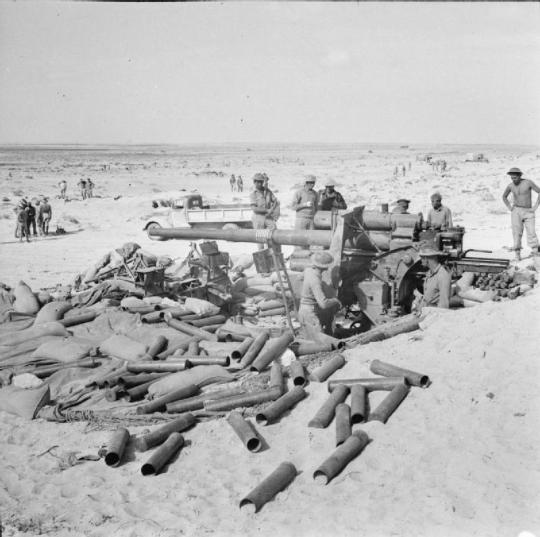
November 7, 1942: British troops inspect an abandoned German 88mm artillery gun along the Coastal Road near El Alamein, as Axis forces begin retreating to Libya.
9) The Battle of Leyte Gulf
Date: October 23- 26, 1944
Location: Leyte Gulf, the Philippines

October 23-26, 1944: A map detailing the four major naval engagements that occurred during the Battle of Leyte Gulf in chronological order (1. Sibuyan Sea, 2. Surigao Strait, 3. Cape Engano, 4. Samar).
The largest naval battle of World War II was the decisive battle of the Pacific Theater. On October 20, 1944, American-led Allied forces began their long- awaited campaign to liberate the Philippines from Japanese occupation with amphibious landings at Leyte Gulf. If the Empire of Japan lost control over the Philippines, they would be cut off from their vital supply of oil from the Dutch East Indies (Indonesia). Despite two years of heavy losses in the Pacific, the Imperial Japanese Navy (IJN) launched a desperate all-out offensive to destroy the U.S. landing force at Leyte Gulf. The IJN Center Force, led by Admiral Takeo Kurita, lost two heavy cruisers to U.S. Navy submarines while sailing through the Palawan Passage in the Western Philippines. The Task Force then came under intense air attacks in the Sibuyan Sea, forcing Kurita to withdraw his ships. The IJN Southern Force was utterly decimated by battleships of the U.S. 7th Fleet further south in the Surigao Strait. The IJN Northern Force centered around three light carriers and Japan’s last major aircraft carrier, Zuikaku, took a severe beating by the Americans at Cape Engano but succeeded in luring the powerful U.S. 3rd Fleet under Admiral William Halsey away from Leyte Gulf.

October 24, 1944: The Japanese super battleship, Yamato, under attack by U.S. Naval aircraft in the Sibuyan Sea. This photograph was taken just after a bomb had struck the ship’s forward gun turret.

October 24, 1944: An American light aircraft carrier, USS Princeton (CVL-23), burns and explodes just east of Luzon after suffering catastrophic damage during the Battle of Leyte Gulf.
Meanwhile, the IJN Center Force, which the Americans believed was retreating, actually turned around and broke through the unguarded San Bernardino Strait, just north of Leyte Gulf, and headed south. With the 3rd Fleet out of position, the U.S. landing force was left exposed and vulnerable. A valiant stand made by a small task force of U.S. screening vessels just east of Samar successfully repulsed the Japanese outside Leyte Gulf and secured victory for the Allies. The result of the battle was the near total destruction of the once powerful Imperial Japanese Navy. Over 12,500 Japanese were killed, and two dozen ships were sunk, including the aircraft carrier Zuikaku, and the super battleship Musashi. The Liberation of the Philippines was all but guaranteed by that point. The United States had severed the link between the Empire of Japan and the oil fields of the Dutch East Indies, and the Allies had secured total naval superiority in the Pacific. For the Japanese, Leyte Gulf had all but assured their defeat in World War II.
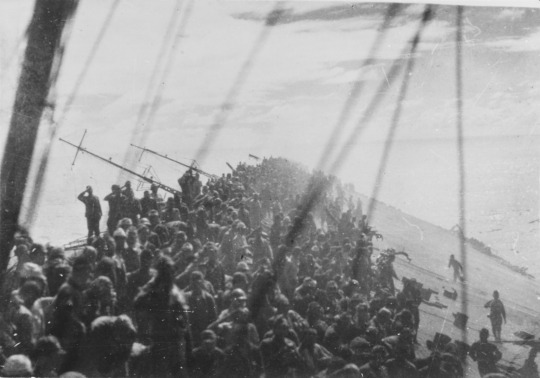
October 25, 1944: With their ship listing heavily and on the verge of sinking, the crew of the aircraft carrier, Zuikaku, salute as the Imperial Japanese flag is lowered.
8) The Battle of Moscow
Date: October 2, 1941- January 7, 1942
Location: Moscow, Russia, Union of Soviet Socialist Republics

December 1, 1941: Soviet troops of the Red Army march through Moscow on their way to fight the Germans on the frontlines just outside the city.
Four months after invading the Soviet Union in Operation Barbarossa, the German Wehrmacht was within striking distance of Moscow. But an offensive on the Soviet capital was delayed due to stubborn resistance by the Red Army at Smolensk and Hitler’s insistence on capturing Leningrad and Kiev first. German commanders argued for an immediate attack on Moscow while the Red Army was still weak and in disarray, but Hitler believed that the fall of Leningrad and the Ukraine would do far more damage economically and militarily to the Soviet Union. This delay gave the Red Army invaluable time to reorganize and reinforce their defenses for the coming battle.
The Soviet Union raised reserve armies, elite units were brought in from Siberia, and several formidable defensive lines were established around Moscow. Only when the Ukraine had been captured and Leningrad encircled did the Wehrmacht resume their advance on the Soviet capital. After two months of intense fighting, the German offensive was bogged down just outside the city due to fierce Soviet defenses, heavy losses, chronic supply shortages, severe winter weather, and Soviet guerrilla fighters operating in the occupied territories. German troops actually came within 15 miles of the Kremlin, but they were woefully unprepared to wage a winter campaign, and thousands froze to death.

November 30, 1941: Two German soldiers on guard duty just west of Moscow endure the harsh conditions of the Russian Winter.
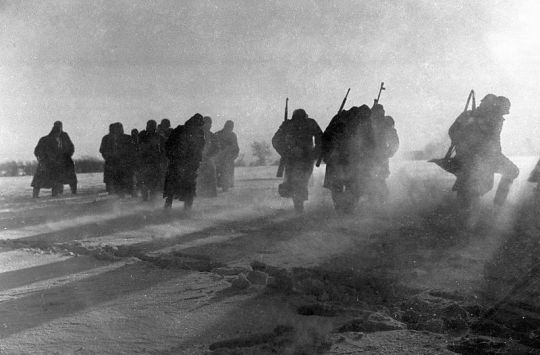
December 27, 1941: A group of German soldiers march across an icy snow-covered field during the Battle of Moscow.
Reinforced by reserve units and Siberian troops, the Red Army launched a massive counteroffensive with over 1,100,000 men. Unlike the Germans, the Russians were perfectly trained and equipped to fight in winter conditions. Despite determined resistance, the exhausted German Army was gradually driven back and defeated.
The Battle of Moscow was a major symbolic and psychological victory that galvanized the Soviet Union. While the losses of 1941 were horrific, the Red Army would rebuild and grow stronger as the war went on. Hitler originally believed that the Soviet Union would be defeated by the end of 1941, but this assessment proved to be wildly optimistic. Nazi Germany was confronted with the prospect of fighting a long war of attrition on the Eastern Front. The Axis Powers were unprepared for a prolonged campaign of this scale, which they were bound to lose the longer it went on.
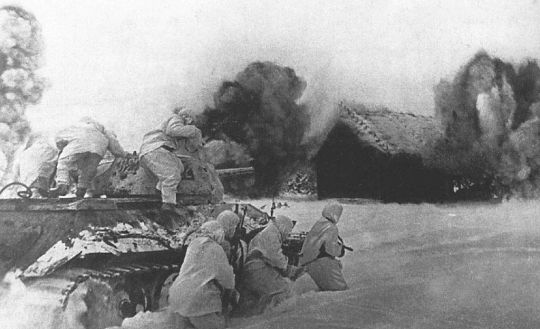
December 31, 1941: A Soviet T-34 Tank with supporting Infantry attack a German-controlled village just outside Moscow.
7) The Battle of Kursk
Date: July 5- August 23, 1943
Location: Kursk, Russia, Union of Soviet Socialist Republics
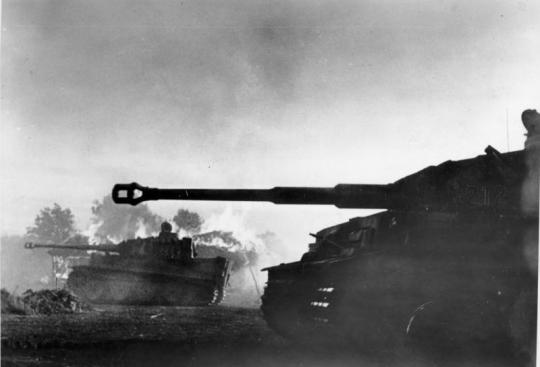
July, 1943: German Tiger I tanks prepare to attack Soviet defenses in the northern sector of the salient around Kursk, Russia.
Seeking to regain the initiative on the Eastern Front after the catastrophic defeat at Stalingrad, Nazi Germany assembled a massive force to encircle and destroy Red Army formations around the city of Kursk. Soviet and British intelligence agencies had attained information of the coming offensive months in advance, giving the Red Army plenty of time to prepare defenses. German forces along the Eastern Front were already badly under strength; gathering troops and resources for an attack on Kursk would take time. The Germans significantly delayed the start of the offensive as they waited for the delivery of additional armored vehicles, including the new advanced Panther tanks and the fearsome Tiger Tanks. Meanwhile the Red Army continued to fortify its positions. By the time the Germans attacked, the Soviets had established a series of formidable defensive lines around Kursk, turning the area into a giant fortress. The ensuing battle would go down in history as the largest clash of tanks in the annals of warfare, including a particularly savage tank battle at the town of Prokhorovka just southeast of Kursk.

July, 1943: German troops from the 2nd SS Panzer Division with a Tiger I Tank on the offensive against the Red Army during the Battle of Kursk.
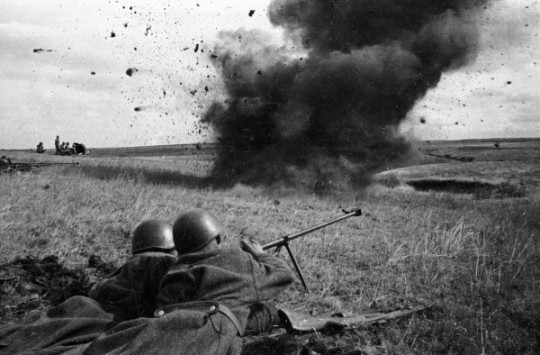
July, 1943: Soviet troops armed with PTRD-41 anti-tank rifles come under heavy fire as they defend the southern sector of the Kursk salient.
The Soviets suffered incredibly heavy losses, but German losses in tanks, equipment, and personnel were irreplaceable. The exhausted Wehrmacht had barely made it halfway through Soviet defenses when, at the height of the battle, Hitler called off the offensive. He then proceeded to transfer troops from Russia to Italy in preparation for an Invasion by the Western Allies. By July 16, the Wehrmacht had withdrawn to its original frontline around the Kursk salient. Once the Germans had been significantly weakened, the Red Army unleashed its massive reserves in a crushing counteroffensive to the north and south of Kursk, capturing key cities, and inflicting even heavier losses on the Wehrmacht. From that point on, the Soviet Union would remain on the offensive until the end of the war. The Red Army had evolved dramatically from the disasters of 1941, transforming itself into an efficient military force to be reckoned with. The Battle of Kursk had completely shattered the Wehrmacht’s offensive capabilities on the Eastern Front. Nazi Germany was doomed to fight a defensive war it could not hope to win against a massive army that was growing in strength and numbers.

September, 1943: Following their victory in the Battle of Kursk, the Red Army launches a major counteroffensive against the Germans near Bryansk, Russia.
6) The Battle of Britain
Date: July 10- October 31, 1940
Location: British Airspace

September 7, 1940: A Heinkel He 111 bomber flown by the German Luftwaffe takes part in a bombing raid over the docks in the East End of London, England.
After the fall of France in June 1940, Nazi Germany had established its dominance over Western Europe. Only Great Britain remained unscathed. When the British refused to accept Germany’s terms for peace, Adolf Hitler ordered the Luftwaffe (Air Force) to establish air superiority over Britain in preparation for a large-scale airborne and amphibious invasion codenamed Operation Sea Lion. Wave after wave of German fighters and bombers flew across Southern England attacking key military and industrial sites while seeking to destroy British fighter aircraft in air-to-air combat. From the start of the campaign, the Luftwaffe faced stubborn resistance from the fighter pilots of the Royal Air Force (RAF). Advancements in the development of radar gave the British a critical advantage, allowing them to detect and track German aircraft taking off from airfields in Nazi-occupied Europe. This, along with information from ground observers, allowed the British to scramble fighters and accurately intercept Luftwaffe formations over England. The Battle of Britain became a grueling war of attrition with heavy losses on both sides. As the air battles intensified in scale and frequency, RAF Fighter Command was increasingly pushed to its breaking point. British airfields were continuously being bombed, the RAF was struggling to field adequately trained new pilots to replace those lost in battle, and those who were still flying were on the brink of exhaustion.

September 7, 1940: Smoke rises from fires raging at the Surrey Docks in London following a Luftwaffe bombing raid.

September 7, 1940: A group of Czech fighter pilots and their British flight commanders with Squadron 310 enjoy a much-needed break at their airfield in Duxford, England. Foreign volunteers from around the world would help play a vital role with the RAF in the Battle of Britain.
On the night of August 25, RAF bombers launched a surprise attack against Berlin in retaliation after German aircraft had accidentally bombed London the previous night. In response, an enraged Hitler ordered the Luftwaffe to bomb British cities into ruins. By targeting the civilian population instead of military airfields, the Germans gave the RAF invaluable time to rebuild their fighter squadrons and repair their infrastructure. Believing that the RAF had been neutralized, the Germans were shocked when the British took to the skies with renewed strength, inflicting heavy losses on Luftwaffe formations. Unable to achieve air superiority over Southern England after three months of bitter fighting, Hitler cancelled Operation Sea Lion so he could focus on the coming war with the Soviet Union. For the British, this was a huge symbolic and psychological victory. It was the first major defeat suffered by Nazi Germany, and it would come to have major strategic ramifications. Great Britain would become the staging point for Allied campaigns to liberate Africa and Europe from Axis control. The failure to knock Britain out of the war would ultimately come back to haunt Hitler.

September 25, 1940: A gun camera records the action as a Supermarine Spitfire flown by a British pilot in the Royal Air Force (RAF) 609 Squadron, engages a formation of Heinkel He 111 bombers near Bristol, England.
5) Operation Barbarossa
Date: June 22- December 5, 1941
Location: Union of Soviet Socialist Republics (Ukraine, Belarus, the Baltic States, Russia, and Eastern Poland).

June 22, 1941: Troops of the German Wehrmacht invade the Soviet Union in what would become the largest and bloodiest campaign in the annals of warfare.
Operation Barbarossa was the largest military campaign in the history of warfare. Led by Nazi Germany, the Axis Powers amassed over four million troops for the invasion of the Soviet Union. Taken completely off guard by the speed and ferocity of the German Blitzkrieg, Soviet units along the western frontier were utterly decimated. The German Wehrmacht demonstrated clear superiority in leadership, training, tactics, weaponry, and combat experience over the Red Army. The Soviet Union suffered over four million casualties, entire formations were destroyed, and large swaths of territory fell under Nazi occupation. But as time went on, the invasion gradually lost momentum. The Germans were slowed by stubborn Soviet defenses in key battles at Brest Fortress, Minsk, Smolensk, Uman, Odessa, Kiev, Sevastopol, and Rostov. The deeper the Axis forces pushed into the Soviet Union, the further they stretched their supply lines to the breaking point. Months of savage fighting and the ongoing logistical crisis took its toll on the invaders.

July 16, 1941: German Cavalrymen enter a town near Mogilev, Byelorussia (Belarus) after intense fighting with the Red Army.

September 1, 1941: Soviet troops man defensive positions around Leningrad. Unable to capture the city during Operation Barbarossa, Axis forces would lay siege to Leningrad for over two years until the Red Army finally relieved the city on January 24, 1944.
While the Red Army had suffered appalling losses, the Soviet Union was able to mobilize its vast resources in manpower and industry to replace what they had lost. The Soviets were also aided tremendously by massive logistical and economic aid provided to them by the United States through the Lend-Lease Act. Soviet troops fought with increased skill and tenacity after learning harsh lessons from the early stages of the war. Far from breaking the Soviet Union, the Wehrmacht was confronted with increasingly fierce resistance. The Germans lacked the strength to seize Leningrad by force, so they laid siege to the city for over two years in a failed attempt to starve the defenders into submission. Elsewhere, German troops were slowed by the autumn rains which turned the roads to mud, and the onset of winter grounded them to a halt just outside Moscow. Despite achieving spectacular victories during the initial period of the invasion, Operation Barbarossa ended in failure for the Axis Powers. Both sides faced the prospect of a long war of attrition, which Nazi Germany had little hope of winning. With superior manpower and resources, the Soviet Union would grow stronger as the war progressed. Hitler’s dream of expanding the German Reich by conquering the Russian homeland would ultimately set the stage for his demise.

October, 1941: Mechanized German units battle Soviet troops in the streets of Kharkov, Ukraine.
4) The Battle of the Atlantic
Date: September 3, 1939- May 8, 1945
Location: Atlantic Ocean

October, 1941: Escorting a large supply convoy across the Atlantic Ocean, officers on the bridge of a British destroyer scan the waters for signs of German U-Boats.
The Battle of the Atlantic was the longest and most bitter campaign fought during World War II. It lasted from September 1939, when the war in Europe broke out, to May 1945 when Nazi Germany surrendered. It was also the largest battlefield in history, covering the entire Atlantic Ocean, from the shores of Europe and Africa, to the coasts of North and South America. As an island nation, Great Britain was entirely dependent on a constant flow of supplies shipped in from across the Atlantic. The German Kriegsmarine (War Navy) sought to cut Britain’s lifeline by enforcing a naval blockade. Germany's surface fleet proved to be no match for the powerful Royal Navy, but their most effective ships against the British hid silently beneath surface, striking with little to no warning. German U-Boats swarmed the Atlantic, hunting and sinking Allied merchant ships at will. The period from 1940 to 1941 was the most difficult for the Allies as hundreds of ships and their precious cargo were sunk.

November 27, 1941: An American SB2U Vindicator Scout-Bomber from the aircraft carrier, USS Ranger (CV-4), flies an anti-submarine patrol for an Allied supply convoy headed for Cape Town, South Africa.

March, 1942: Allied tanker, Dixie Arrow, begins to break in half and sink to the bottom of the Atlantic after being torpedoed by German submarine U-71.
Despite traveling with armed surface escorts, Allied merchant convoys were facing coordinated hit-and-run attacks by U-Boats operating in groups called “wolf packs.” At times, the Germans actually came close to severing the shipping routes to Great Britain. But by 1942, the tide of the war was turning against Germany. A combination of new tactics, technology, and intelligence helped the Allies defeat the U-Boats, such as the development of sonar, improved anti-submarine countermeasures, increased air cover by Allied aircraft, the massive production of merchant ships and escorts by the United States, and the breaking of the enigma code used by U-Boats to communicate via radio. The tables had turned in the Atlantic, as the hunters became the hunted. By 1943, the U-Boat threat had been effectively neutralized. From 1939 to 1945, 3,500 Allied merchant vessels were sunk, along with 175 warships, and 72,000 Allied seamen had lost their lives in the Atlantic. The Germans lost 783 U-Boats, and out of the 40,000 men who served in the U-Boat fleet, 30,000 were killed. Germany’s campaign to starve the British into submission, had ended in failure. With the naval blockade broken, the Allies were able to build up their forces in Great Britain for the coming invasion of Nazi-occupied Europe.

November 5, 1943: German submarine U-848 comes under attack by U.S. Naval aircraft in the South Atlantic.
3) The Battle of Midway
Date: June 4- 7, 1942
Location: Midway Atoll, 1,300 miles west of Hawaii

June 6, 1942: A Squadron of American SBD Dauntless dive bombers from the aircraft carrier, USS Hornet (CV-8), fly over a burning Japanese heavy cruiser near Midway.
This was the battle that many regard as the turning point of the Pacific Theater. By May 1942, the Empire of Japan had conquered most of the western Pacific, while the U.S. Pacific Fleet was still weakened from losses suffered during the surprise Japanese attack on Pearl Harbor five months earlier. During the Battle of the Coral Sea (May 4- 8), the Pacific Fleet managed to repel a Japanese offensive in New Guinea and cripple two IJN aircraft carriers, but the Americans lost the aircraft carrier USS Lexington. The U.S. Navy was left with only three aircraft carriers to counter Japan’s next move in the Pacific. Meanwhile the Imperial Japanese Navy was planning a major offensive which they hoped would destroy the U.S. Pacific Fleet once and for all. By seizing a strategic airfield just west of Hawaii on the island of Midway, Japanese commanders hoped to force the U.S. Navy to commit its valuable aircraft carriers to repel the invasion. Once lured out of Pearl Harbor, the American carriers would be destroyed by superior Japanese forces in a battle to retake the island. But unbeknownst to the Japanese, U.S. naval intelligence had deciphered their radio transmissions and uncovered their plan to invade Midway.

June 4, 1942: The American aircraft carrier, USS Yorktown (CV-5), suffers a direct hit from a torpedo dropped by a Japanese B5N torpedo bomber during the Battle of Midway.

June 6, 1942: The Japanese Heavy Cruiser, Mikuma, suffers catastrophic damage from U.S. Naval air attacks during the Battle of Midway. This picture was taken by an SBD Dauntless shortly before the Mikuma sunk into the Pacific Ocean.
When the Combined Japanese Fleet sailed in to attack, all three American aircraft carriers were already waiting near Midway, ready to spring the trap. Taken completely by surprise, four Japanese aircraft carriers were sunk for the destruction of one American carrier, the USS Yorktown. For the United States, this was a victory of epic proportions. The Japanese carriers sunk near Midway: Akagi, Hiryu, Kaga, and Soryu, were four of the six carriers that had carried out the attack on Pearl Harbor. Imperial Japan’s aura of invincibility was shattered and their ability to carry out offensive operations had been severely degraded. It was a devastating defeat from which the Japanese would ultimately never recover from. The scale of their victory at Midway gave the United States invaluable time to gather their strength as they prepared to go on the offensive in the Pacific. The Americans were able to raise and repair many of the ships lost at Pearl Harbor and their massive industrial economy produced new warships at a rate that the Japanese could never match. For the Empire of Japan, the Battle of Midway was the beginning of their downfall.

June 20, 1942: USS Ballard picks up survivors from the Japanese aircraft carrier, Hiryu, two weeks after it was sunk by U.S. Naval aircraft during the Battle of Midway.
2) The Invasion of Normandy
Date: June 6- August 30, 1944
Location: Normandy, France

June 6, 1944: U.S. troops from the 1st Infantry Division disembark from a Coast Guard Landing Craft and advance towards a section of the Normandy coastline designated Omaha Beach during the Allied Invasion of Nazi-occupied France.
This was the battle that decided the fate of Western Europe. After years of planning, preparations, and training, Allied forces based in Great Britain were finally ready to launch the long-awaited Invasion of Nazi-occupied Europe. Across the English Channel, the Germans constructed a series of formidable defensive fortifications along the European coastline, dubbed the “Atlantic Wall.” Stretching from the Bay of Biscay in western France all the way to the arctic coast of Norway, the Nazi regime began building the wall in 1942 to repel any Allied Invasion of Western Europe. The Allies finally chose to carry out landings on the Normandy Peninsula, a region of Northern France which was reported to be the weakest section of the Atlantic Wall. In the meantime, Allied Intelligence carried out an elaborate deception campaign that kept the Germans confused as to where and when the invasion would take place.
In the early morning hours of D-Day, June 6, 1944, nearly 160,000 troops from several nations crossed the English Channel by sea and air destined for Normandy, France. Just after midnight, Allied airborne units were dropped inland behind German coastal defenses. Even though the paratroopers were badly scattered across Normandy, they still managed to capture key targets and were highly successful in creating chaos and confusion among German forces. The French Resistance assisted the Allies by harassing enemy troops and carrying out acts of sabotage on the German transportation and communication network in the region.

June 6, 1944: Landing craft carrying Canadian troops of the Royal Winnipeg Rifles towards Juno Beach during the D-Day Invasion of Normandy.
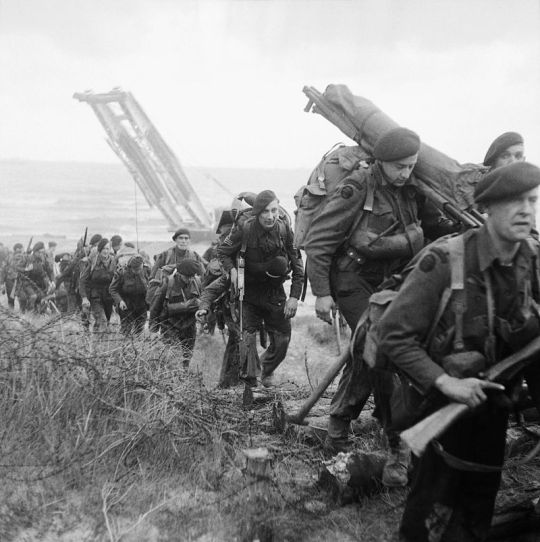
June 6, 1944: Royal Marine Commandos attached to the 3rd Infantry Division of the British Army advance into Normandy after landing on Sword Beach.
At dawn, the amphibious landings were successfully carried out along the Normandy coast with Allied troops capturing Gold, Sword, Juno, and Utah Beaches. U.S. troops faced the strongest defenses on Omaha Beach, where they suffered heavy casualties but still managed to overcome fierce German resistance to secure a small beachhead. Assisted by overwhelming air and naval firepower, the Allies were able to establish a foothold in Normandy. Allied troops gradually pushed further inland capturing key cities, such as Carentan, Cherbourg, and Caen. On July 25, the Allies launched Operation Cobra, a major offensive from Normandy, which lead to a rapid advance across France. The once powerful German Wehrmacht collapsed in the face of the onslaught. On August 25, Allied troops marched triumphantly into Paris, liberating the French Capital after four years of occupation. For the Western Allies, it was the defining Battle of World War II. For Nazi Germany, it was the beginning of the end as they were slowly crushed by the combined forces of the United States, Great Britain, France, and the Soviet Union.

July, 1944: U.S. troops of the 4th Armored Division advance through the town of Coutances during Operation Cobra, a major Allied offensive that would lead to the breakout from Normandy and the collapse of German armies across France.
1) The Battle of Stalingrad
Date: August 23, 1942- February2,1943
Location: Stalingrad (Volgograd), Russia, Union of Soviet Socialist Republics.

February, 1943: Soviet troops fighting across the ruins of Stalingrad, Russia. For over five months, the Red Army and the Wehrmacht fought bitterly for control of the city, resulting in the bloodiest and most destructive battle of World War II.
Many have regarded Stalingrad as the turning point of World War II. Not only was it the bloodiest urban battle ever fought, it was the single deadliest battle in history. After failing to outright destroy the Soviet Union during the initial invasion in 1941, Adolf Hitler sought to cripple the Soviet economy by seizing the oilfields of the Russian Caucasus. As Axis forces advanced into southern Russia, the German 6th Army was sent to capture the city of Stalingrad. Named after Soviet dictator Joseph Stalin, the city was symbolically meaningful for both sides. It was also a key industrial and transportation center for the region. Before the battle, the Luftwaffe mercilessly bombed Stalingrad, turning it into a heap of burning rubble. When the Wehrmacht finally launched its ground assault, they were met with fanatical resistance. German and Soviet troops fought block by block, street by street, and house to house for control of the city. Soviet reinforcements were rushed across the river Volga under heavy fire, and despite appalling casualties they managed to help prevent the city from falling completely into enemy hands. Parts of Stalingrad such as Mamayev Kurgan, the Central Railway Station, the Red October Factory, Pavlov’s House, the Grain Elevator, and even the sewers attained a level of infamy for the scale of death and suffering both sides endured during the battle.

October, 1942: A German soldier armed with a Russian PPSh-41 submachine gun looks out over the rubble of the Barrikady Factory in Stalingrad.

October, 1942: Soviet soldiers armed with German and Russian submachine guns defend the Red October Factory in Stalingrad from German attacks.
The Germans committed scores of troops and resources to the takeover of Stalingrad but left their flanks guarded by weaker Romanian, Hungarian, and Italian units. With the Russian winter on its side, the Red Army launched a massive counteroffensive with over one million troops against the weakened flanks to the north and south of Stalingrad. The Soviets broke through as the Romanians, Hungarians, and Italians collapsed in disarray. German troops in and around Stalingrad were horrified to find that they had been completely encircled by the massive Red Army. An offensive to break through to the city along with attempts by the Luftwaffe to resupply Stalingrad by air ended in complete failure. Freezing in subzero temperatures, ravaged by frostbite, starvation, and disease, German troops inside the shattered city fought valiantly but were eventually overwhelmed by the Red Army. Never before had Nazi Germany suffered a defeat so catastrophic.
The Battle of Stalingrad led to the destruction of the German 6th Army, elements of the 4th Panzer Army, along with the Romanian, Hungarian, and Italian Armies on the Eastern Front. In total, the Axis Powers suffered 850,000 casualties. It was a devastating loss from which they would never recover from. It is estimated that the Soviet Union suffered over 1,129,000 total casualties during the battle, but they had still prevailed. Galvanized by their historic victory, Soviet forces relentlessly pushed westward, driving the Germans all the way back to Berlin, culminating in the collapse of Hitler’s Third Reich in May 1945.
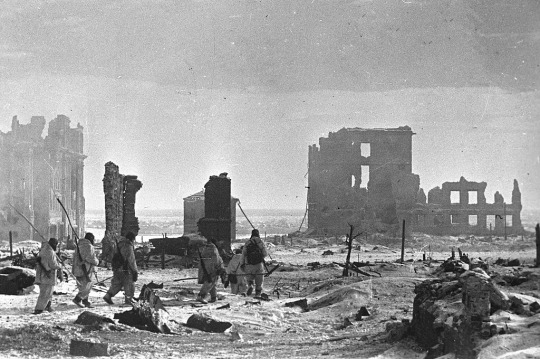
February 2, 1943: Soviet soldiers move through the center of Stalingrad following it’s liberation from German occupation.
(c) Daniel Ramos. January, 2016. No part of this article shall be reproduced in any manner without attribution to the author.
#world war II#battle of el alamein#north african campaign#battle of leyte gulf#philippines campaign#pacific theater#battle of moscow#eastern front#battle of kursk#battle of britain#western front#operation barbarossa#siege of leningrad#battle of the atlantic#u-boats#battle of midway#invasion of normandy#normandy landings#operation overlord#d-day landings#battle of stalingrad
11 notes
·
View notes